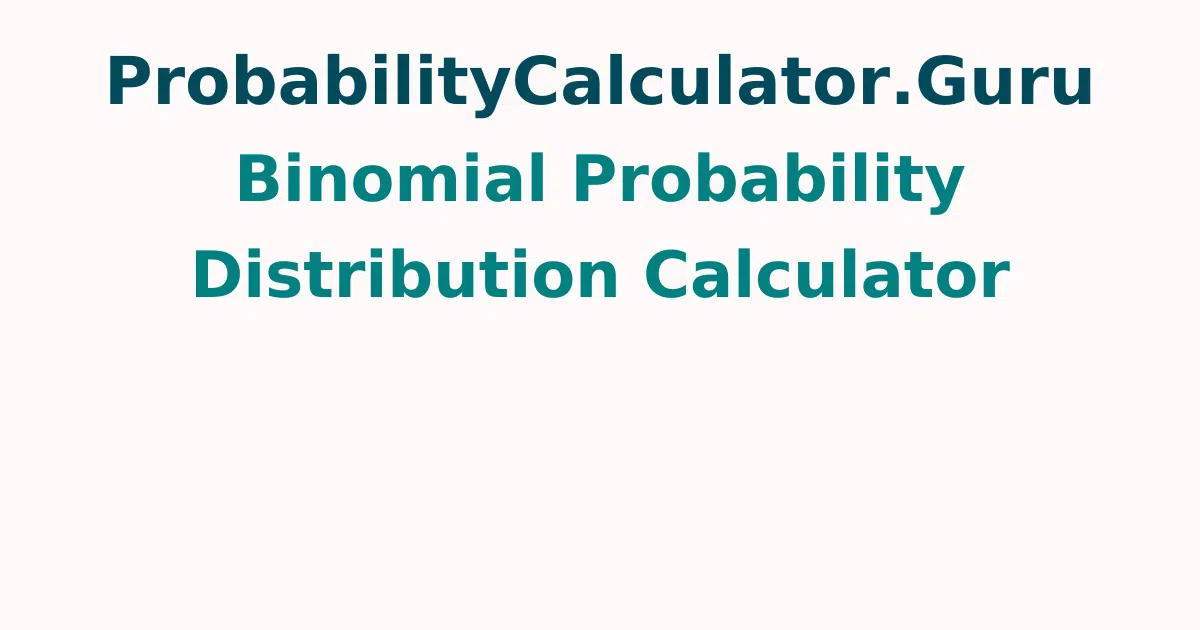Binomial Probability Distribution Calculator Or Binomial Probability Calculator
Created By : Vaibhavi Kumari
Reviewed By : Phani Ponnapalli
Last Updated : Mar 19, 2023
Welcome to our Binomial Probability Distribution Calculator! This tool helps to compute the binomial distribution probability of a certain number of success in a sequence of events fastly & easily. All you need to do is enter the number of trials n, probability of success per each trial, number of success details in the mentioned input fields and tap on the calculate button to get displayed with the result in a short span of time.
What is Binomial Distribution?
The binomial distribution is defined as the probability distribution of a binomial random variable. In binomial probability distribution, the number of success in a sequence of experiments, and each time a question asked for yes/no, and the boolean value outcome is represented as either true/yes/success/one (probability p) or false/no/failure/zero (probability q = 1 - p).
The applications of the binomial distribution are in YES/NO survey, the number of votes collected in an election, the number of male and female candidates at a work station.
The properties of the binomial distribution are listed here.
- In every binomial distribution, there are only two possible outcomes: yes or no.
- There is n number of independent trials or a fixed number of repeated trials.
- The probability of success or failure is different for every trial.
- Every trial is independent that says that the outcome of one trial does not affect another trial outcome.
- Only the number of success is calculated for n independent trials.
Binomial Probability Distribution Formula Or Binomial Distribution Formula Calculator
The binomial distrobution formula for any random variable x is given as
P(x:n,p) = nCx px (1-p)n-x
or
P(x:n,p) = nCx px qn-x
For a binomial distribution, the mean, variance, standard deviation formulas are here:
Mean, μ = np
Variance, σ² = npq
Standard Deviation σ= √(npq)
Where,
p is the probability of success
q is the probability of failure
n is the number of experiments
x is the random variable
The binomial distribution formula can also be written as P(x:n,p) = n!/[x!(n-x)!].px.(q)n-x.
How to Calculate Binomial Probability Distribution?
- Make a note of the number of experiments, probability of success in each experiment and number of success details.
- Subtract probability of success from 1 to get probability of failure.
- Place the known values in the binomial distribution formula.
- Perform the required calculations to get the binomial probability value.
Example:
A coin is tossed 5 times, find the probability of getting at least 2 tails.
Solution:
Number of trials n = 5
Probability of tail p = ½
Probability of tail q = 1 - p = 1 - ½ = ½
For exactly 2 tails
P(X = 2) = 5C2 p2 q5-2
= 5! / 2! 3! × (½)2 × (½)3
= 5/16
Therefore, probability of getting at least 2 tails is 5/16.
Study more probability concepts from our site probabilitycalculator.guru to make your calculations easier.
FAQ’s on Binomial Distribution Probability Calculator
1. How do you find the probability of a binomial distribution calculator?
Students have to give required input details such as the total number of trials n, probability of success per trial p and number of success x. Press the calculate button to get the binomial probability distribution value as output.
2. What is the formula for the mean and variance of the binomial distribution?
The formulas to calculate the mean and variance of the binomial distribution are here. IN the following sections, n is the number of trials, p is the probability of success and q is the probability of failure. Binomial calculator can be used.
Mean = np
Variance = npq
3. How many parameters does a binomial distribution have?
A binomial probability distribution is a discrete probability distribution having two parameters represented as n and p.
4. What is the purpose of the binomial distribution?
The binomial probability distribution allows finding the probability of observing a specified number of "success" when the process is repeated a countable number of terms and outcome should be either a success or a failure.
